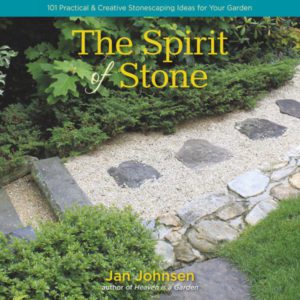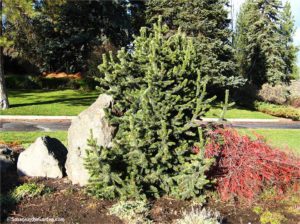Book Review: “The Spirit of Stone”

 The Spirit of Stone: 101 Practical & Creative Stonescaping Ideas for Your Garden by Jan Johnsen (2017, St. Lynn’s Press, 191 pp., $21.95)
The Spirit of Stone: 101 Practical & Creative Stonescaping Ideas for Your Garden by Jan Johnsen (2017, St. Lynn’s Press, 191 pp., $21.95)
You might think a book that is essentially about rocks would be rather dull. It turns out that isn’t the case at all, as I learned while working my way through The Spirit of Stone. As a matter of fact, the more I read, the more I started rethinking my landscape design and wondering how I could incorporate more stone into it.
Author Jan Johnsen truly knows her stuff. While attending college in Kyoto, Japan, she developed her love of stone and gained an appreciation for the way its placement in a garden affects us. She has been a professional landscape designer for many years and shares her knowledge, tips and designs throughout the book.
In the first chapter, she details how stones have been used throughout history to define a sense of place. This includes standing stones, cairns or towers of stones, Chinese scholars’ stones with holes and hollows, Japanese viewing stones on platforms, split rocks, and stone circles. As she discusses each type, she includes tips for using them to make an impact.
 Chapter two covers different types of rock gardens and how to place them within a landscape. She shows how to make a rock garden on a slope, ways to move rocks (since they’re so darned heavy), and has tips for placing rocks within a rock garden. Johnsen also includes a rock outcrop garden (take-home message: don’t hide it!), crevice gardens made with flat stones placed vertically, a gravel garden, and dry landscape gardens that we know as Zen gardens with raked gravel.
Chapter two covers different types of rock gardens and how to place them within a landscape. She shows how to make a rock garden on a slope, ways to move rocks (since they’re so darned heavy), and has tips for placing rocks within a rock garden. Johnsen also includes a rock outcrop garden (take-home message: don’t hide it!), crevice gardens made with flat stones placed vertically, a gravel garden, and dry landscape gardens that we know as Zen gardens with raked gravel.
The next chapter introduces ways to use stone for functional purposes in an environmentally-friendly landscape.
“Natural stone comes directly from the earth and is the original sustainable material,” Johnsen writes. “It is 100% recyclable, can be cleaned with water, does not emit any harmful vapors, and endures for lifetimes.”
One of the best examples is that stones can be used to help with drainage. She lists the different types of gravel and how to create gravel walkways. There is a lot of useful information on building dry streams to catch runoff in areas of a landscape that have drainage issues. The dry streams can slow down the water so it enter the soil.
Johnsen also discusses the use of stone mulch. Instead of using organic mulches like ground bark, stone mulch is extremely long-lasting. The downside, of course, is that stone mulch doesn’t add nutrients to the soil like organic types do.
What I enjoyed as I read this book were the many tips interspersed with information, all from the author’s personal uses of different materials. This makes her ideas seem very doable.
There is a chapter on stone walks and how different designs affect us. Johnsen suggests using irregular layouts of stones or pavers and mixing types of stone materials. She adds tips for creating attractive and useful walkways by making sure they’re wide enough for two people to walk side by side and to accommodate necessary equipment.
If you live on a slope, you’ll probably find the chapter on garden steps of great interest. She talks about how they make gardens more easily accessed, create a focal point and add drama. What a shame I live on a flat lot! And, as expected, she includes the details on how to install steps.
There are chapters on creating stone walls and adding stone accents to your garden, with tips on placement for maximum effect.
In chapter eight, the author makes recommendations for pairing plants with stone. This includes shade-tolerant plants, those that will grow in rock crevices, plants with golden foliage, and ones that spill over rocks to soften the edges and create a more natural look.
At the end of the book, there is an extensive list of public gardens where the reader can check out the use of stones with the landscape.
If you are looking for inspiration for your own landscape, along with the background on the many ways to add stone, The Spirit of Stone is a great place to start.
